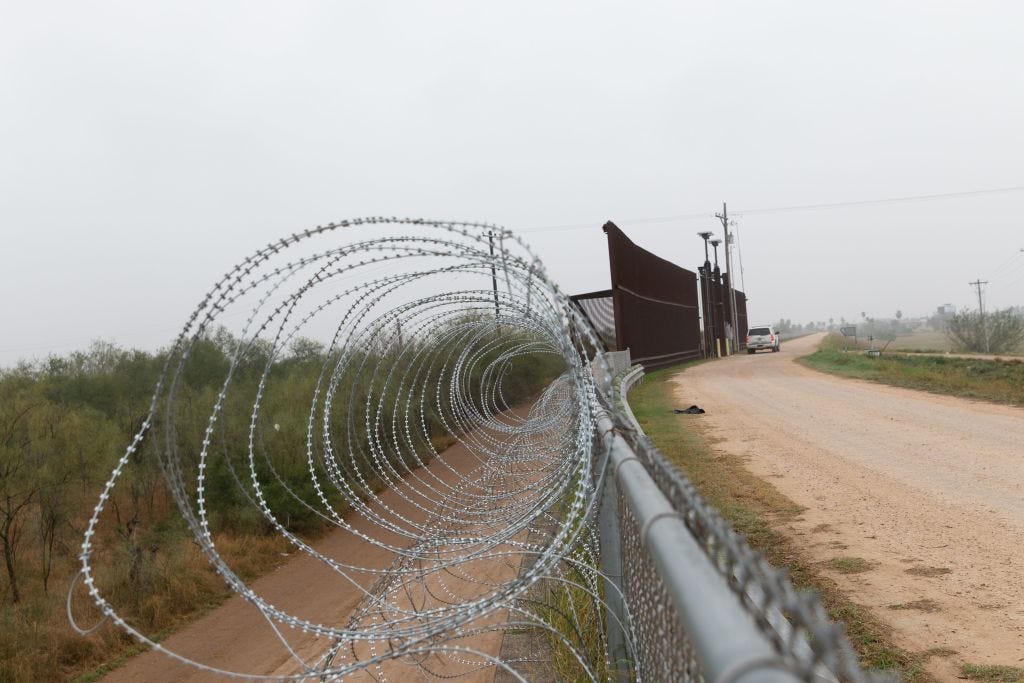|
 |
The Southern Border May Not Be Our Achilles Heel for Terrorism
The statistics show that perhaps deterrence has actually worked
Recent major attacks in Israel, Iran and Russia suggest Islamic-inspired terror might be making a global comeback. So in the United States, we’d be foolish to believe we are immune to attempts to attack us. This month FBI Director Christopher Wray told Congress that he’s never seen “so many threats to our public safety and national security” at once. Where are these threats coming from? Wray has expressed unease about our porous southern border, which he believes terrorists may try to exploit. Still, to date, no terrorist has arrived on American soil by illegally crossing the border. How concerned should we be about this?
During this election year, immigration has grown to be one of Americans’ top concerns. According to Gallup, Americans believe immigration is now the single most important problem facing the country today, and there’s no doubt that a good deal of this feeling springs from fears about possible terrorist infiltration. Former President Trump frequently links the threat of terror attacks to lax border policies, and many Americans agree with his point. An attack originating from across our border would certainly grab people’s attention and likely have a big influence on voters’ thinking at the ballot box.
But when you look at the data, it seems that perhaps concerns about being exposed to terrorism via our southern border are largely unfounded. While we should be vigilant, we should also be rational about the terrorist threats the border poses.
Reasons to Worry…
Our national defenses against terrorism have certainly improved overall since the Sept. 11 attacks. After years of lawmaker foot-dragging on border security, the Enhanced Border Security Act became law in 2002, making it tougher for would-be terrorists to enter the country. Congress periodically has examined the threat of the southern border as a terrorism conduit: In 2012, the House Homeland Security Subcommittee on Oversight released its “A Line in the Sand” report, which raised fears that Osama Bin Laden intended to recruit terrorists with Mexican passports to infiltrate the southern border. The report states that former senior U.S. officials like Secretary of Homeland Security Janet Napolitano thought that potential terrorists may have entered the country through the border.
Still, despite these improvements, the crisis at the southern border continues to loom large as a major vulnerability. Last year, U.S. Customs and Border Protection (CBP) officers apprehended 2 million people trying to enter the U.S. and refused entry to another 1.1 million. Moreover, since 2021, nearly 1.8 million individuals are “got aways”—people who crossed the border illegally but who were never processed by U.S. law enforcement and might still be in the country. It seems at least plausible that a few of these individuals might be terrorists.
Late last year, the House Judiciary Subcommittee on Immigration Integrity, Security and Enforcement held hearings on how the southern border might be used to smuggle attackers into our country. In his testimony to the subcommittee, Todd Bensman of the Center for Immigration Studies emphasized that large numbers of immigrants on the watchlist trying to cross the border are causing our counterterrorism programs to fail. He also said that “terrorist actors abroad are by now well aware that the U.S. southern border poses far less of an impediment or deterrent to illegal entry than in years past.”
The news coming from the border continues to be sobering. In fiscal year 2023, the CBP apprehended 169 individuals found in the FBI’s Terrorism Screening Data Base (colloquially known as “the watchlist”) between ports of entry at the southern border, up from 98 in 2022. Earlier this year, a man detained at the border admitted that he was a Hezbollah-trained terrorist and planned on building a bomb in the U.S. (It is unclear if he had made the watchlist.) This month, we also learned that the CBP had released into the U.S. an Afghan man associated with Hezb-e-Islami, a State Department-designated terrorist group, prior to his immigration hearing despite his presence on the watchlist.
…But Within Reason
All this sounds troubling, but we need to add some important context. Alex Nowrasteh of the Cato Institute disputes Bensman’s findings, emphasizing that no terrorist has ever committed an act of terrorism in the U.S. after first slipping through the southern border. Rather, most terrorists in the U.S. either were born here or came into the country on visas or as legal refugees. In an exhaustive study published this month, Nowrasteh explains that since 1975, 230 foreign-born terrorists have committed terror attacks in the U.S. Among this group, 79 were lawful permanent residents, 43 were on tourist visas, 24 were on student visas and 29 were refugees. The rest were either here legally under other programs, or their visa status couldn’t be determined. One of the 19 9/11 terrorists had a student visa; the rest had tourist or business visas. Only nine illegal immigrants have attempted terror attacks on U.S. soil, with no fatalities.
Interestingly enough, the numbers show that the individuals on the watchlist encounter U.S. law enforcement far more frequently on the northern border with Canada than they do on our southern border. Nowrasteh points out that, of the nine illegal migrants convicted of planning a terrorist attack, only three crossed the U.S.-Mexico border—all ethnic Albanians who came to the country as young children. Another stowed away on a ship. But the remaining five came into the U.S. via the Canadian border. In fiscal year 2023, 484 individuals on the watchlist encountered CBP agents at northern ports of entry.
In recent years, a few legal immigrants have committed terrorism in the U.S., most notoriously at Inland Regional Center in San Bernardino, California, in 2015 and the New York City bicycle path attack in 2017. Nowrasteh determines that over the time frame of his study, the odds of being killed by a terrorist were vanishingly small—1 in 4.5 million—although he is quick to add such an attack by an illegal immigrant still remains plausible.
Terrorism of any kind, of course, is extremely serious, and even minor incidents should raise concern. But the federal government fuels fear by putting out a garbled message on the terrorism threat. Last September, the Department of Homeland Security claimed the risk from foreign and domestic terrorism remained high. In fact, the overall level of terrorism in the U.S. from any source now is extremely low, as we know from the government’s own statistics. Last year, Homeland Security stated that only three attacks by violent extremists have occurred since 2022. We haven’t experienced an attack by radical Islamic terrorists in several years.
These low numbers are confirmed by independent sources. According to New America, only 16 Americans died last year in terrorist-related violence. Some of these cases are hard to distinguish from hate crimes or other forms of homicide. Lately, some incidents identified as terrorist-related appear to be the actions of disturbed individuals, such as the Idaho teen planning to attack local churches with a knife and butane lighters in the name of ISIS.
The U.S. is likely benefiting from a global decline in terrorist activity. Total incidents in 2023 were down 22% from the previous year, and nearly all of these attacks occurred in conflict zones, according to the Global Terrorism Index. Despite this positive trend, the FBI’s terrorism watchlist has nearly doubled in six years to 2 million names of individuals with terrorist ties. But if someone on the watchlist is encountered on the border, it does not mean this individual is a terrorist—only that some U.S. official determined that the individual’s background merited a closer look.
Clearly, the many false positives on the terrorism watchlist are by design: The guiding principle of the watchlist is “better safe than sorry.” The increase in the size of the watchlist may be contributing to our spotting more tagged individuals attempting to enter the U.S., even if they’re not actually terrorists and don’t intend to carry out any terrorist-related activity.
More Theoretical Than Real
Deterrence on our southern border hasn’t worked for drug smugglers or illegal migrants, but it just might be working for terrorists. The threat of terrorists using the southern border for entry always was “much more of a theoretical vulnerability than an actual one,” according to former National Counterterrorism Center head Nicholas Rasmussen. In fact, the southern border probably is too risky a means for terrorists to enter the country. As noted from CBP statistics above, individuals on the terrorism watchlist are getting caught.
If a terrorist organization goes to the trouble of recruiting, training and financing an aspiring terrorist, why put them at greater risk of encountering U.S. law enforcement before they even enter the country? There is a strong chance now that indeed they will be at least interrogated by CBP and have their biometrics taken. Would-be terrorists also might make themselves vulnerable to predatory human traffickers and other smugglers at the border. Finally, we should consider the opportunity cost; it probably is easier to enter the U.S. by other means. As we see from Nowrasteh’s data, applying for a tourist or student visa might offer a better chance of success.
Terrorism in the U.S. is almost always carried out by citizens or legal residents and remains a low but persistent threat. The massive surge of migrants at the southern border has been an ongoing crisis for U.S. policy and a major challenge for U.S. law enforcement. But the influx of potential terrorists at our southern border seems to be largely an unsubstantiated fear.
You’re currently a free subscriber to Discourse .

